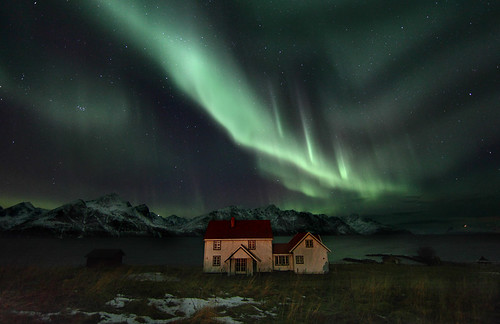An aurora (plural: auroras or aurorae) is a natural light display in the sky particularly in the high latitude (Arctic and Antarctic) regions, caused by the collision of energetic charged particles with atoms in the high altitude atmosphere (thermosphere). The charged particles originate in the magnetosphere and solar wind and, on Earth, are directed by the Earth's magnetic field into the atmosphere. Aurora is classified as diffuse or discrete aurora...In northern latitudes, the effect is known as the aurora borealis (or the northern lights), named after the Roman goddess of dawn, Aurora, and the Greek name for the north wind, Boreas, by Pierre Gassendi in 1621 (Wikipedia)

By Thorbjørn Riise Haagensen on Flickr.
The Old Norse word for the aurora borealis is norðrljós, "northern lights". The first occurrence of the term norðrljós is in the book Konungs Skuggsjá (The King's Mirror, known in Latin as Speculum Regalae), written in 1250 AD, after the end of the Viking Age (the Viking Age dates ca. 800-1100AD), describing the Northern Lights as seen by settlers in Greenland. (Viking Answer Lady).

By Thorbjørn Riise Haagensen on Flickr.
For thousands of years people in the northern part of the world have marveled at the spectacular and fearful displays that occasionally light up the night sky.
There have been hundreds of stories and theories to explain these celestial lights what we now know as the aurora borealis or northern lights. But no one until about a century ago, suspected a connection with the sun.
Every northern culture has oral legends about the aurora, passed down for generations. During the viking period, northern lights were referred to as reflections from dead maidens.
The phenomenon was often referred to as a vengeful force. In ancient times, most people were afraid of the lights. Some people would not let their children outside to play while there were auroras, fearful they could get killed. Norwegian Space Centre)

By Norseman1968 on Flickr.
The best times for viewing the northern lights is September-April, and (in Norway) above 70 degrees north. That said, it is not unheard of at all to see auroras further south in Norway (and in North America, for that matter).
Up at the sæter, Oleanna sees the first aurora of the year in September 1904. Though she's excited, she's forgotten the tale that the lights are a path between the living and the dead...
Seeing the Northern Lights is most definitely on my bucket list!
ReplyDelete@Meg: Me too, for sure!
ReplyDeleteI was in Tromso, Norway last month. The Northern Lights were spectacular!
ReplyDelete@Marianne: I'm so envious! How fantastic!
ReplyDelete